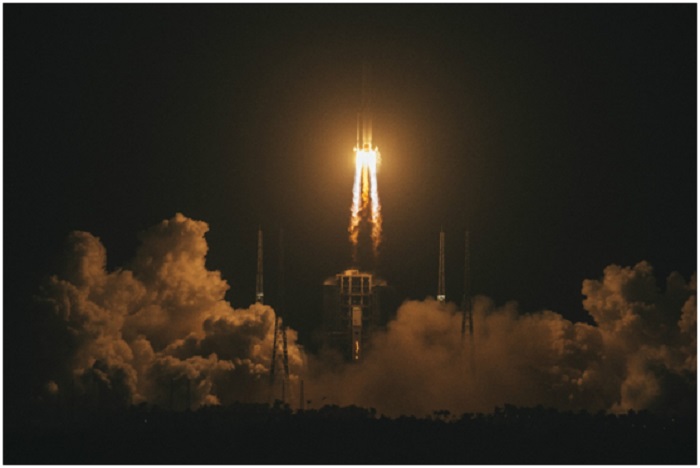



China’s Chang’e-5 probe landed at the preselected landing area on the moon at 23:11, Dec. 1, after it entered the lunar orbit for a week.
At 22:00 on Dec. 2, after the probe worked for about 19 hours on the moon, the spacecraft completed automatic sampling on the moon and sealed the samples in a container insider its ascender as planned.
The landing process of Chang’e-5 is different from that of its two predecessors, Chang’e-3 and Chang’e-4 in certain aspects.
During its landing process, the probe reduced its flying speed, adjusted its position quickly, continued approaching the lunar surface, hovered while avoiding obstacles and descended at a slower speed before a final fall on the moon.
It is the wisdom and accumulated technological experience of many researchers that ensured the smooth landing of Chang’e-5.
The landing process of Chang’e-5 is also a process of choosing a launching site for its ascender to blast off from the moon, said an executive with the China Academy of Space Technology (CAST), the developer of the probe.
Different from its two predecessors, the new lunar probe requires unprecedented location accuracy and flatness of its landing site. There should not be too high bumps and deep pits in the landing area, and the gradient of the landing site should also meet the requirements. In this sense, the landing process is the choice of a landing site.
To enable the probe to choose an ideal landing site and achieve accurate landing, the 502 Research Institute of the CAST adopted the method of accurately avoiding both large and smaller obstacles for it, which was also applied in the missions of Chang’e-3 and Chang’e-4.
Thanks to the probe’s guidance, navigation and control (GNC) system, the lander-ascender combination of Chang’e-5 first quickly started its high-thrust engine and used the reverse brakes to reduce its flying speed.
While conducting rapid positional adjustments, the lander-ascender then took pictures of the preset landing area to identify and avoid large obstacles.
At 100 meters above the moon, the lander-ascender hovered to take pictures of the selected area in a more detailed way and carried out accurate detection of smaller obstacles to avoid them.
Then it began to incline downward to the selected landing site and then descend vertically when it reached right above the landing area.
When the craft was close enough to the lunar surface, it switched the engine off and made a soft landing with its “legs” cushioning the impact of the landing.
Remaining stable is crucial to a smooth landing. A buffer mechanism is required to absorb shock and ensure that the probe will not tip over or sink into the lunar surface when the lander-ascender touched down on the surface. This is one of the technical problems for the probe’s landing.
For Chang’e-5, its extraordinary four landing “legs” are its buffer mechanism. With complete intellectual property rights, the mechanism guarantees that the legs can be folded easily and unfolded safely, solving problems such as landing buffer and stability.
Compared with the landing buffer design scheme of Chang’e-3, the buffer capacity requirements of Chang’e-5 increased by 30 percent and yet the weight target of the probe’s legs reduced by 5 percent, as it would carry out more challenging tasks.
Two more delicate designs were involved for the landing process of Chang’e-5. It seems that the lander “carries” the ascender and landed on the lunar surface. However, during the landing process, the lander relied on a computer, the “strongest brain” that the ascender uses to take off from the moon surface, as well as a star sensor for positional adjustment. That’s designers’ clever move based on the fact that the ascender accompanies the lander during the whole landing process, saving costs while reducing the weight of the probe.
As the lunar dust thrown up by the probe’s main engine when it approached the lunar surface will contaminate the star sensor, which will affect the ascender’s take-off, researchers designed a dust cover to protect the lens of the star sensor.
The star sensor was covered when the lander-ascender flew above the lunar surface at a certain height, and then uncovered when the combination landed on the moon and the dust was dispersed.


The Humanitarian Service Diamond Awards has.
A Chinese Company, Inner Galaxy Steel.


The Programme Coordinator, Regulatory, Compliance and.


A Non-Governmental Organization (NGO), Committee for.
The Trustfund Pensions Limited has chided.


The House of Representatives Committee on.
The China General Chamber of Commerce.


Senator Chuka Utazi who represented Enugu.


An Abuja based Legal Practitioner, Ugochukwu.


The African business community in Yiwu,.
Leave a Comment